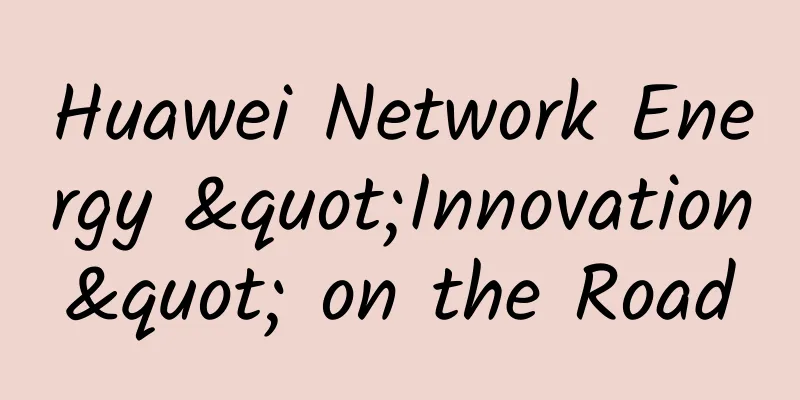Huawei Network Energy "Innovation" on the Road

|
[51CTO.com original article] Introduction: "Data center energy innovation is carried out around customer value, achieving overall customer value TVO***, improving reliability and optimizing CAPEX through data center architecture reconstruction and integrated innovation, injecting "i³" intelligent technology into the entire product series, optimizing OPEX from end to end throughout the life cycle, and improving reliable power supply and distribution, efficient temperature control, efficient operation and maintenance, and other aspects of guarantee." Zhang Guanghe, chief engineer of Huawei EBG China Network Energy Solution Sales Department, was recently interviewed by our reporter and elaborated on Huawei's technological innovation.
Zhang Guanghe, Chief Engineer of Huawei EBG China Network Energy Solution Sales Department Zhang Guanghe said, "Huawei Network Energy has also integrated artificial intelligence technology into its solutions, and used AI technology to improve data center energy efficiency and simplify operation and maintenance. This is one of its ten artificial intelligence application pilot projects to cope with the challenges brought by the large-scale development of data centers and the massive edge computing. Huawei's DCIM+ solution, which combines artificial intelligence, achieves "monitoring, management, operation, and control" of data centers through intelligent automatic detection, intelligent data analysis, and intelligent decision execution, reducing the difficulty of operation and maintenance and improving availability." The data center is divided into three layers, namely basic equipment and components, computer room, and IT system. From the perspective of technological innovation, the core components of the first layer are very important, including the core components of the power supply system and the core components of the cooling system. The basic core components are like the bricks and tiles used to build a building. Only when the quality of each brick and tile is excellent can the quality of the building be guaranteed at the most basic level. "The goal of Huawei's Network Energy Department is to make these two core components perfect." Zhang Guanghe explained from the three reliability points. One is the reliability of the technology. Huawei will ensure that the equipment can run for a long time without damage. Second, operational reliability. When a system failure occurs, customers can quickly repair it to ensure business continuity. The third is the reliability of the architecture, which can prevent problems before they occur and detect them in advance. Pursuing the best product performance is not Huawei's only goal. Creating value for customers is the focus of Huawei's technological innovation. The traditional refrigeration system has been slow to iterate in recent years, so Huawei has restructured its architecture. For example, the evolution of DC frequency conversion technology can increase the efficiency of traditional frequency conversion by 30%. Another major innovation is the application of micro-modules. In the past, each component of the data center was independent, and the UPS, IT load, and refrigeration system were independent and inefficient. So Huawei organically integrated them and intelligently matched each component system while ensuring the reliability of the architecture. At present, customers generally have three pain points: first, the uncertainty of services and rapid launch, with very short delivery time; second, the operation cycle requires green energy saving, reducing the difficulty of operation and maintenance, and improving operation efficiency; third, complex management. How to solve customer pain points is also what Huawei needs to consider at the technical level in 2019. "Operation and maintenance are difficult, and it is difficult to recruit talents. So can we use artificial intelligence technology to reduce the difficulty of operation and maintenance? For example, in terms of green energy saving, by injecting artificial intelligence into the temperature control system, Huawei inputs multiple parameters such as the end of the chiller, cooling tower, water pump, IT load, internal temperature field, external temperature field, etc., and adjusts the key links through neural network calculation to achieve intelligent optimization, which not only reduces the difficulty of operation and maintenance but also saves energy consumption; in terms of talents, Huawei has formed codes with the experience of hundreds of operation and maintenance centers. The intelligent system of the data center will collect all the lines and automatically dispatch orders if there are any problems, reducing the requirements for operators; in terms of management experience, Huawei provides managers with a resource visualization platform, allowing managers to know at any time how much space resources and power resources the data center has, and which assets are operating healthily during their life cycle..." Huawei's innovative technologies have brought real value to customers. Not long ago, Huawei built a data center outdoors in just 13 days. Compared with the traditional implementation time of seven to eight months or even a year, Huawei's network energy solution helps customers save a lot of time and labor costs. In 2018, Huawei Network Energy made great achievements in government security, Internet, finance, education, medical care, power and other industries, especially in the field of government security, which was well recognized by customers. The reporter believes that in 2019, Huawei Network Energy, with accurate positioning, clear goals and strong technical support capabilities, will surely burst out with stronger market vitality, and the future is promising. [51CTO original article, please indicate the original author and source as 51CTO.com when reprinting on partner sites] |
<<: How should a small LAN with less than 10 or 100 people be established?
Recommend
Server-Speaks-First is a bit of a bummer, protocol detection and opaque ports in Linkerd 2.10
[[416375]] This article is reprinted from the WeC...
The competition among the four major data center host network virtualization technologies
Since it is the virtualization of the host networ...
The three major operators simultaneously announced the new layout of Wi-Fi 6 and entered the "three-gigabit era" in 2020
Recently, the three major operators have made cor...
5.5G industry accelerates again! Qualcomm 5G Advanced-ready chip commercial terminals will be launched in the second half of the year
MWC 2023 is about to be held, and the 5G Advanced...
my country's industrial Internet platform construction faces four major bottlenecks
The Guiding Opinions of the State Council on Deep...
The United States has repeatedly stumbled in 5G network construction. What did it do wrong?
The fact that the 5G network in the United States...
Xiezhong's progress is remarkable丨2019 H3C Automotive Industry CIO Forum accelerates smart upgrades across the board
After years of sustained rapid growth, my country...
TCP protocol status analysis, super complete~
Today I will talk to you about the state analysis...
Two ways to decrypt HTTPS traffic with Wireshark
principle Let's review the entire handshake p...
The potential of smart education continues to be released, and 5G brings three major boosts
Education is the foundation of a century-long pla...
DediPath: 1Gbps unlimited dedicated server with 15% off from $38/month, VPS hosting with 45% off from $1.57/month, data centers in Los Angeles/San Jose, etc.
DediPath offers promotional discounts for all its...
Telecommunications Unions always merge when things get tough: the operator version of "The Wolf is Coming"
I wonder if you have noticed this strange phenome...
Analysis of the Art of Communication between Computers
Network Basics First, let's talk about networ...
Riverbed Redefines APM, Helps Enterprises Promote Digital Transformation
[51CTO.com original article] It is obvious that d...
CloudServer: $12/quarter-single core, 4G memory, 30G NVMe disk, 5TB/10Gbps New York data center
CloudServer is a foreign hosting company founded ...









